#herndon of the horn
Text








THE CHILDREN OF GARTH GREENHAND
Harlon the Hunter and Herndon of the Horn, twin brothers who built their castle atop Horn Hill and took to wife the beautiful woods witch who dwelled there, sharing her favors for a hundred years (for the brothers did not age so long as they embraced her whenever the moon was full).
#asoiafsource#asoiafedit#valyrianscrolls#asoiafminorhouses#harlon the hunter#herndon of the horn#preseries#gifs#ours#childrenofgarthgreenhand*
104 notes
·
View notes
Text
Dragon Babies: The Cost of a Magical Bloodline | ASoIaF & HotD Theory an...
youtube
#asoiaf#game of thrones#hotd#house targaryen#daenerys targaryen#rhaenyra targaryen#daemon targeryan#valyria#mirri maz duur#danelle lothston#night king#corpse queen#night queen#stannis baratheon#melisandre#harlon the hunter#herndon of the horn#Youtube
4 notes
·
View notes
Text
Antonio Velardo shares: This County Has Predicted the President Since 1980 by Astead W. Herndon, Karen Hanley, Dave Horn and Caitlin O’Keefe
By Astead W. Herndon, Karen Hanley, Dave Horn and Caitlin O’Keefe
Voters in one county in Washington State have picked the winner in every presidential election from Reagan to Biden. What do they think now, a year from Election Day?
Published: November 13, 2023 at 04:21PM
from NYT U.S. https://ift.tt/oIew9Zj
via IFTTT

View On WordPress
0 notes
Photo



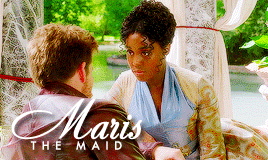






Some Celebrated Children of Garth Greenhand
❀ John the Oak, the First Knight, who brought chivalry to Westeros (a huge man, all agree, eight feet tall in some tales, ten or twelve feet tall in others, sired by Garth Greenhand on a giantess). His own descendants became the Oakhearts of Old Oak.
❀ Gilbert of the Vines, who taught the men of the Arbor to make sweet wine from the grapes that grew so fat and lush across their island, and who founded House Redwyne.
❀ Florys the Fox, the cleverest of Garth's children, who kept three husbands, each ignorant of the existence of the others. (From their sons sprang House Florent, House Ball, and House Peake).
❀ Maris the Maid, the Most Fair, whose beauty was so renowned that fifty lords vied for her hand at the first tourney ever to be held in Westeros. (The victor was the Grey Giant, Argoth Stone-Skin, but Maris wed King Uthor of the High Tower before he could claim her, and Argoth spent the rest of his days raging outside the walls of Oldtown, roaring for his bride.)
❀ Foss the Archer, renowned for shooting apples off the head of any maid who took his fancy, from whom both the red apple and green apple Fossoways trace their descent.
❀ Brandon of the Bloody Blade, who drove the giants from the Reach and warred against the children of the forest, slaying so many at Blue Lake that it has been known as Red Lake ever since.
❀ Owen Oakenshield, who conquered the Shield Islands, driving the selkies and merlings back into the sea.
❀ Harlon the Hunter and Herndon of the Horn, twin brothers who built their castle atop Horn Hill and took to wife the beautiful woods witch who dwelled there, sharing her favors for a hundred years (for the brothers did not age so long as they embraced her whenever the moon was full).
❀ Bors the Breaker, who gained the strength of twenty men by drinking only bull's blood, and founded House Bulwer of Blackcrown. (Some tales claim Bors drank so much bull's blood he grew a pair of shiny black horns.)
❀ Rose of Red Lake, a skinchanger, able to transform into a crane at will—a power some say still manifests from time to time in the women of House Crane, her descendants.
❀ Ellyn Ever Sweet, the girl who loved honey so much she sought out the King of the Bees in his vast mountain hive and made a pact with him, to care for his children and his children's children for all time. She was the first beekeeper, and the mother to House Beesbury.
❀ Rowan Gold-Tree, who was so bereft when her lover left her for a rich rival that she wrapped an apple in her golden hair, planted it upon a hill, and grew a tree whose bark and leaves and fruit were gleaming yellow gold, and to whose daughters the Rowans of Goldengrove trace their roots.
#asoiafedit#gotedit#fantasyedit#john the oak#gilbert of the vines#florys the fox#maris the maid#foss the archer#brandon of the bloody blade#owen oakenshield#harlon the hunter#herndon of the horn#bors the breaker#rose of red lake#ellyn ever sweet#rowan gold tree#i've been wanting to make this for a while and kept procrastinating#fancasting*
709 notes
·
View notes
Photo




___________________________________________________⠀⠀⠀⠀⠀⠀⠀⠀⠀⠀⠀House Gardener ⠀⠀⠀⠀⠀⠀⠀⠀ ___________________________________________________
#the Reach#highgarden#Garth Greenhand#Garth the Gardener#John the oak#Gilbert of the vines#florys the fox#Maris the maid#foss the archer#Brandon of the bloody gate#Owen oakenshield#harlon the hunter#Herndon of the horn#bors the breaker#Rose of the red lake#ellyn ever sweet#Rowan gold tree#house tyrell#olenna redwyne#queen of thornes#mace Tyrell#alerie hightower#Loras Tyrell#willas Tyrell#garlan tyrell#house Stark#house Redwyne#house Florent#house ball#house Peake
77 notes
·
View notes
Text
Twins in asoiaf:
Recently, I noticed a comment on the internet saying that brother-sister twins are only Targaryen's and that this is another proof/hint that Jaime and Cersei are Targaryen, so I decided to check it out and search for all twins in asoiaf, here are the results:
Twins of one sex from other homes:
Twin brothers:
Aron and Emrick from Fair Isle.
Arryk and Erryk from Reach.
The Fossoway Twins from Reach.
Alyn and Androw Frey.
Dickon and Mathis Frey.
Jaime and Tywin Frey.
Harlon the Hunter and Herndon of the Horn from Reach.
Steffon and Symon Hollard from Crownlands.
Jason and Tyland Lannister.
Martyn and Willem Lannister.
Tywald and Tion Lannister.
Hobber and Horas Redwyne.
Benjen and Brandon Stark.
Cregard and Torrhen Stark.
Twin sisters:
Bandy and Shyra from Winterfell.
The Drinkwater Twins from Dorne.
The Fowler Twins, Jennelyn and Jeyne from Dorne.
Sarra and Serra Frey.
Alysanne and Arianne Tarth.
Now the Targaryen twins of one sex:
Aegon and Aemon Blackfyre.
Aerea and Rhaella Targaryen.
Baela and Rhaena Targaryen.
Maelys Blackfyre.
and the Targaryen twins of two sexes:
Aelor and Aelora Targaryen.
Daenerys Targaryen (daughter of Aegon IV) and stillborn twin brother.
Jaehaera and Jaehaerys Targaryen.
Jeyne and Jon Waters, children of Alyn Velaryon and Elaena Targaryen.
In fact, all twins that do not have Targaryen blood are twins of one sex (also in the Lannisters, by the way even Tyrion in his ADWD dream and in his thoughts in AGOT does not dream of having a twin sister, but a twin brother), only in Targaryen we have twins of two sexes, could George really make a clue of such a thing to Jaime and Cersei?
18 notes
·
View notes
Text
ZIEGFELD FOLLIES
April 8, 1946
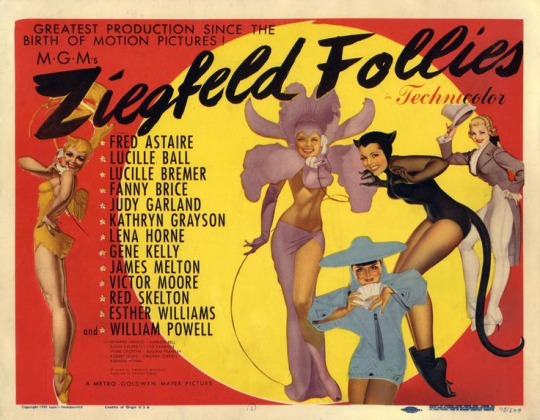
Directors: Lemuel Ayers, Roy Del Ruth. Vincente Minnelli, George Sidney,
Norman Taurog, Charles Walters. Robert Lewis
Producer: Arthur Freed for Metro Goldwyn Mayer
The shooting schedule ran between April 10 and August 18, 1944, with retakes plus additional segments filmed on December 22, 1944 and then between January 25 and February 6, 1945. The film was first proposed in 1939.
Synopsis ~ We meet a grayed, immaculately garbed Florenz Ziegfeld, Jr. in Paradise (his diary entry reads "Another heavenly day"), where he looks down upon the world and muses over the sort of show he'd be putting on were he still alive.
PRINCIPAL CAST

Lucille Ball ('Here's to the Ladies') is appearing in her 64th film since coming to Hollywood in 1933.
Fred Astaire ('Here's to the Ladies' / Raffles in 'This Heart of Mine' / Tai Long in 'Limehouse Blues’ / Gentleman in 'The Babbit and the Bromide') also appeared with Lucille Ball in Roberta (1935), Top Hat (1935), and Follow the Fleet (1936). His name was mentioned twice on “I Love Lucy.”
Lucille Bremer (Princess in 'This Heart of Mine' / Moy Ling in 'Limehouse Blues')
Fanny Brice (Norma Edelman in 'A Sweepstakes Ticket') appeared in the original stage version of many editions of The Ziegfeld Follies on Broadway.
Judy Garland (The Star in 'A Great Lady Has An Interview') also starred with Lucille Ball in Thousands Cheer (1943).
Kathryn Grayson (Kathryn Grayson in 'Beauty') also starred with Lucille Ball in Thousands Cheer (1943).
Lena Horne (Lena Horne in 'Love') also starred with Lucille Ball in Thousands Cheer (1943).
Gene Kelly (Gentleman in 'The Babbit and the Bromide') also starred with Lucille Ball in Thousands Cheer (1943), Du Barry Was A Lady (1943), and A Guide for the Married Man (1967). He made an appearance on the Lucille Ball special “Lucy Moves to NBC” (1980).
James Melton (Alfredo in 'La Traviata')
Victor Moore (Lawyer's Client in 'Pay the Two Dollars')
Red Skelton (J. Newton Numbskull in 'When Television Comes') also starred with Lucille Ball in Having Wonderful Time (1938), Thousands Cheer (1943), Du Barry Was A Lady (1943), and The Fuller Brush Girl (1950). On TV he appeared on “The Lucy-Desi Comedy Hour” in “Lucy Goes To Alaska” (1958). Ball and Skelton appeared in numerous TV specials together.
Esther Williams (Esther Williams in 'A Water Ballet') also appeared with Lucille Ball in Easy To Wed (1946).
William Powell (Florenz Ziegfeld Jr.) also played the same character in The Great Ziegfeld (1936).
Edward Arnold (Lawyer in 'Pay the Two Dollars') appeared with Lucille Ball in Roman Scandals (1933) and Ellis in Freedomland (1952).
Marion Bell (Violetta in 'La Traviata')
Cyd Charisse (Ballerina in 'Beauty') also starred with Lucille Ball in Thousands Cheer (1943).
Hume Cronyn (Monty in 'A Sweepstakes Ticket') was honored by The Kennedy Center in 1986, at the same ceremony as Lucille Ball.
William Frawley (Martin in 'A Sweepstakes Ticket') played the role of Fred Mertz on “I Love Lucy” and “The Lucy-Desi Comedy Hour”. He also appeared on “The Lucy Show,” his final screen appearance.
Robert Lewis (Chinese Gentleman in 'Limehouse Blues' / Telephone Voice in 'Number Please')
Virginia O'Brien (Virginia O'Brien in 'Here's to the Ladies') also starred with Lucille Ball in Thousands Cheer (1943), Du Barry Was A Lady (1943), and Meet The People (1944).
Keenan Wynn (Caller in 'Number Please') appeared with Lucille Ball in Easy To Wed (1946), Without Love (1945), and The Long, Long Trailer (1954).
SUPPORTING CAST

Ziegfeld Girls
Karin Booth
Lucille Casey
Aina Constant
Elizabeth Dailey
Frances Donelan
Natalie Draper
Karen X. Gaylord
Aileen Haley
Carol Haney
Shirlee Howard
Margaret Laurence
Helen O'Hara
Noreen Roth
Elaine Shepard
Kay Thompson
Dorothy Tuttle
Dorothy Van Nuys
Eve Whitney - appeared on “I Love Lucy” episode “The Charm School” (ILL S3;E15).
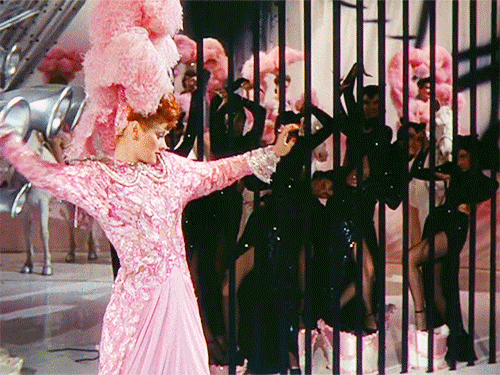
Dancers
Gloria Joy Arden
Jean Ashton
Irene Austin
Judi Blacque
Bonnie Barlowe
Norman Borine
Hazel Brooks
Ed Brown
Kathleen Cartmill
Jack Cavan
Marilyn Christine
Laura Corbay
Rita Dunn
Meredyth Durrell
Shawn Ferguson
Jeanne Francis
Jean French
Mary Jane French
David Gray
Bill Hawley
Doreen Hayward
Charlotte Hunter
Virginia Hunter
Patricia Jackson
Margaret Kays
Laura Knight
Laura Lane
Dale Lefler
Melvin Martin
Diane Meredith
Lorraine Miller
Joyce Murray
Janet Nevis
Ray Nyles
Billy O'Shay
Jane Ray
Dorothy Raye
Beth Renner
Melba Snowden
Walter Stane
Ivon Starr
Robert Trout
Chorus Boys
Rod Alexander
Milton Chisholm
Dick D'Arcy
Dante DiPaolo
Don Hulbert
Herb Lurie
Matt Mattox
Bert May - appeared on “The Lucy Show” in “Lucy and Tennessee Ernie Ford”
Jack Purcell
Tommy Rall
Ricky Ricardi (!)
Alex Romero
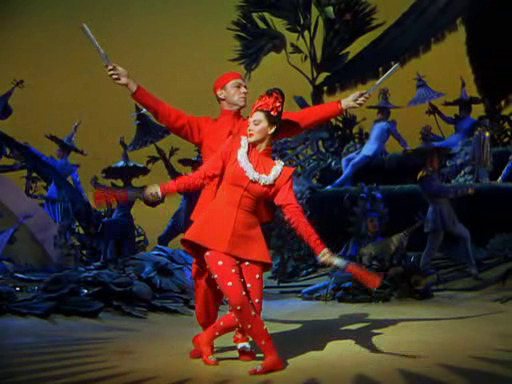
“LIMEHOUSE BLUES” starring Fred Astaire, Lucille Bremer, and Robert Lewis
Robert Ames (Masked Man)
James Barron (Couple with Banners)
Eleanor Bayley (Couple with Branches)
Mary Jo Ellis (Couple with Banners)
Sean Francis (Ensemble)
James King (Rooster)
Harriet Lee (Bar Singer)
Eugene Loring (Costermonger)
Charles Lunard (Masked Man)
Patricia Lynn (Ensemble)
Ruth Merman (Ensemble)
Garry Owen (1st Subway Policeman)
Ellen Ray (Couple with Parasols)
Jack Regas (Masked Man)
Billy Shead (Couple with Parasols)
Ronald Stanton (Couple with Branches)
Wanda Stevenson (Ensemble)
Ray Teal (2nd Subway Policeman)

“LOVE” starring Lena Horne
Juliette Ball (Club Patron)
Lennie Bluett (Dancer)
Suzette Harbin (Flirt)
Avanelle Harris (Club Patron)
Maggie Hathaway (Dancer)
Charles Hawkins (Club Patron)
Marie Bryant (Woman Getting Her Man Taken)
Cleo Herndon (Dancer)

“THIS HEART OF MINE” starring Fred Astaire and Lucille Bremer
Helen Boyce (Countess)
Feodor Chaliapin Jr. (Lieutenant)
Naomi Childers (Duchess)
Charles Coleman (Majordomo)
Sam Flint (Majordomo's Assistant)
Sidney Gordon (Masked Man)
Count Stefenelli (Count)
Robert Wayne (Dyseptic)

“PAY THE TWO DOLLARS” starring Edward Arnold and Victor Moore
William Bailey (Subway Passenger)
Joseph Crehan (1st Judge) - played a Detective on “I Love Lucy” “The Great Train Robbery”
William B. Davidson (2nd Judge)
Eddie Dunn (3rd Subway Policeman)
Harry Hayden (Warden)
George Hill (2nd Subway Policeman)
Wilbur Mack (Subway Passenger)
Larry Steers (Magistrate)
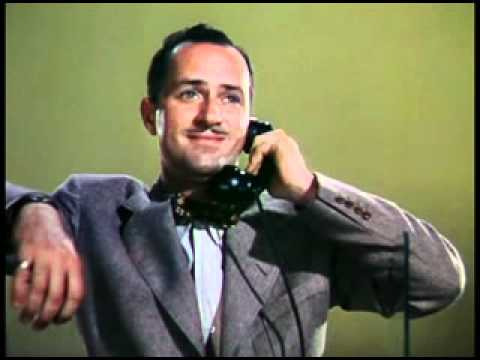
“NUMBER PLEASE” starring Keenan Wynn
Peter Lawford (Voice of Porky)
Grady Sutton (Texan)
Audrey Totter (Phone Operator Voice)
Kay Williams (Girl)
OTHERS
Bunin's Puppets
Elise Cavanna (Tall Woman)
Jack Deery (Man)
Rex Evans (Butler in "A Great Lady Has An Interview”)
Sam Garrett (Roping / Twirling Act)
Silver (Horse in "Here's to the Ladies')
Arthur Walsh (Telegraph Boy in "A Sweepstakes Ticket") - appeared on “I Love Lucy” in “Lucy Has Her Eyes Examined” (ILL S3;E11).
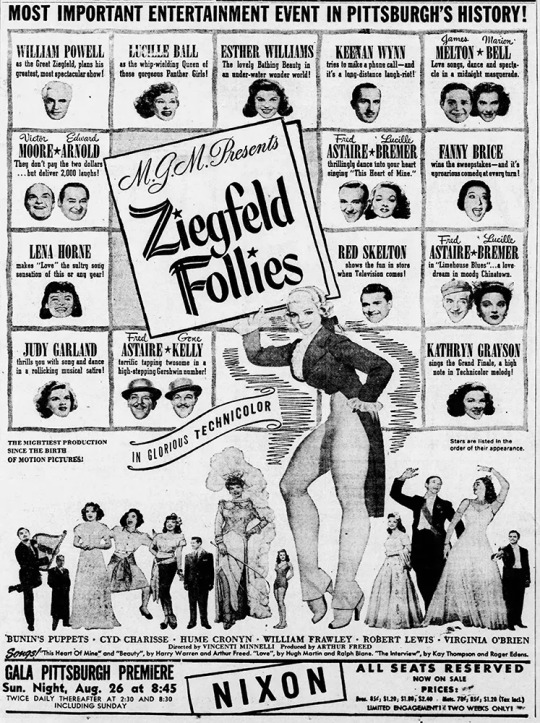
‘FOLLIES’ TRIVIA
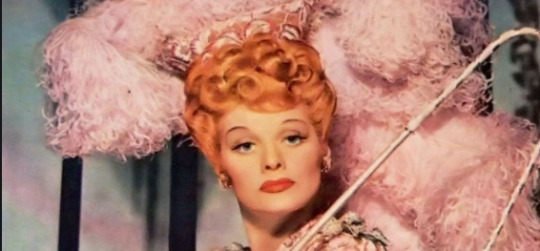
Sidney Guilaroff, Lucille Ball’s hair dresser, who takes responsibility for her famous ‘golden red’ for this movie, becoming her trademark color.
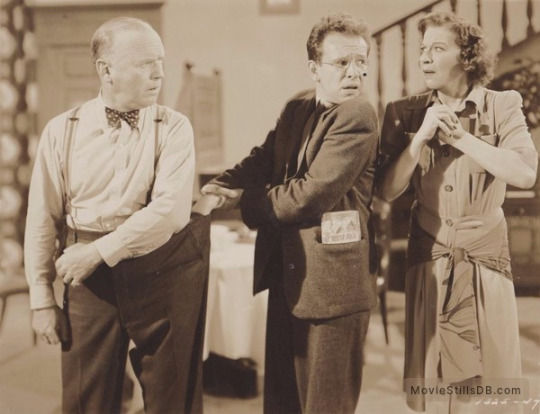
Although they appear in different segments, this is the only feature film collaboration between “I Love Lucy co-stars" Lucille Ball and William Frawley. Coincidently, Frawley's character in this film shares a striking similarity with his iconic character of Fred Mertz on “I Love Lucy.” In this film he plays a money-hungry curmudgeon of a landlord, much like the show. In the above photo, he appears with director Minnelli and co-star Brice.

The horse ridden by Lucille Ball is the Lone Ranger's Silver!

Lucille Ball was actually fired by Ziegfeld from his road company production of Rio Rita in the 1930s.

In February 1956, Lucy and Desi appeared on “MGM Parade” to promote their MGM film Forever Darling. The show also included footage of Lena Horne singing from Ziegfeld Follies.
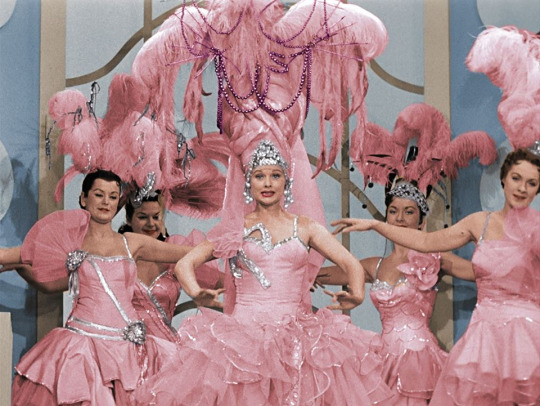
Lucy also played a showgirl in pink in “Lucy Gets Into Pictures” (ILL S4;E19) aired on February 21, 1955. The scene was inspired by Ziegfeld’s legendary stage shows featuring beautiful women wearing elaborate costumes navigating long staircases. To solidify the comparison, Ricky says he is going to a meeting with Mr. Minnelli. Vincente Minnelli was one of the directors of Ziegfeld Follies.

Lucy Ricardo had previously cavorted around in a lampshade in the manner of a Ziegfeld girl in both the unaired pilot and “The Audition” (S1;E6).

Ziegfeld Follies includes a sketch for Red Skelton called “When Television Comes” aka “Guzzler’s Gin” in which a (future) television spokesman gets increasingly sloshed on his product. This sketch was an obvious influence on Lucy’s Vitameatavegamin routine in “Lucy Does a TV Commercial” (ILL S1;E30) aired on May 5, 1952.

Ziegfeld Girl Eve Whitney appeared on “I Love Lucy” episode “The Charm School” (ILL S3;E15). She used her own name for the character.
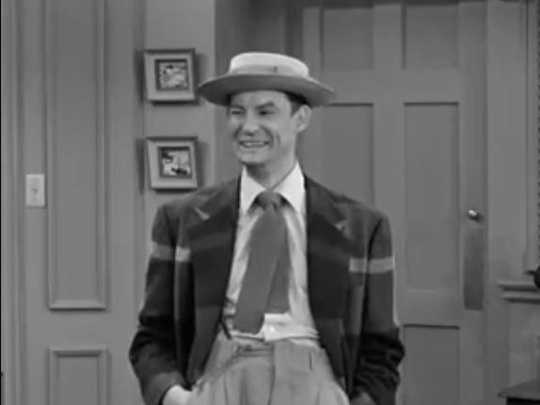
The Telegraph Boy in "A Sweepstakes Ticket" Arthur Walsh - appeared on “I Love Lucy” in “Lucy Has Her Eyes Examined” (ILL S3;E11) as Arthur ‘King Cat’ Walsh. He teaches Lucy how to jitterbug.
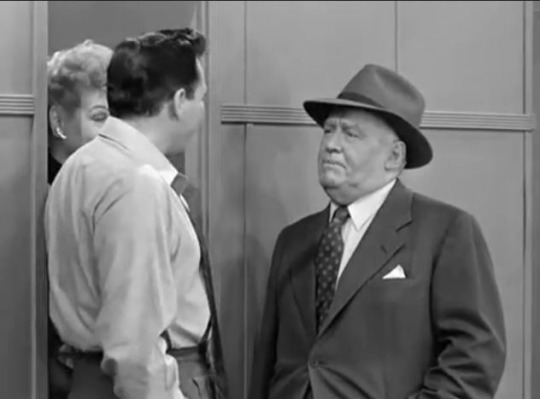
The first Judge in the “Pay the Two Dollars” James Crehan also played the Police Detective on “I Love Lucy in “The Great Train Robbery” (ILL S5;E5) first aired on October 31, 1955.

Porky, a voice on the telephone in “Number Please” Peter Lawford, played “Password” against Lucille Ball on September 24, 1964. At the time, Lawford was married to President Kennedy’s sister, Patricia. On November 26, 1968, Ball was a guest on “The Tonight Show” when Peter Lawford was sitting in for Johnny Carson.
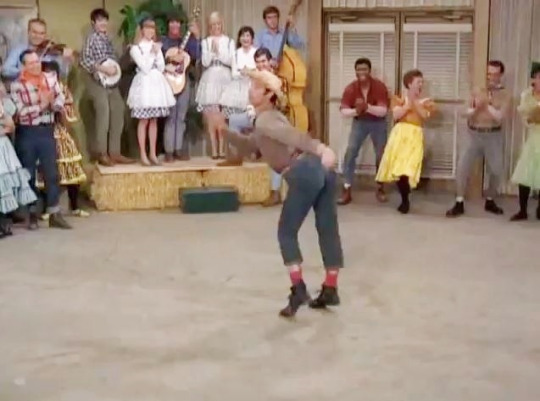
Chorus Boy Bert May appeared as a solo dancer on “The Lucy Show” in “Lucy and Tennessee Ernie Ford” (TLS S5;E21) in February 1967.

In the dressing room, Lucy jokes with Fanny Brice, one of the funniest women in showbusiness. This was the only time Ball and Brice collaborated and was Brice’s last film.

Ziegfeld’s follies began on Broadway, so it was appropriate that the show featured past and future Broadway musical stars:
Lucille Ball ~ Wildcat (1960)
Carol Haney ~ The Pajama Game (1954)
Tommy Rall ~ Call Me Madame (1950)
Fanny Brice ~ The Ziegfeld Follies
Marion Bell ~ Brigadoon (1947)
Victor Moore ~ Anything Goes (1934)
There was a lot of material that was not filmed, but written and cast. Some of the original skits would have added “Lucy” performers Mickey Rooney, Ann Sothern, and Van Johnson to the cast.
#Ziegfeld Follies#Lucille Ball#Florenz Ziegfeld#1946#MGM#Fanny Brice#Fred Astaire#William Frawley#Arthur Walsh#Eve Whitney#Bert May#peter lawford#James Crehan#I love lucy#Red Skelton#Keenan Wynn#Gene Kelly#Judy Garland#Esther Williams#Lucille Bremer#Lena Horne#Vincente Minnelli#William Powell#Cyd Charisse
60 notes
·
View notes
Photo

♛ → THE REACH present(s) LYNORA TARLY, the LADY of HORN HILL. when the dragons danced in the sky they thought the BLACKS would still fly, but in the blink of an eye, they would all die. the TWENTY-TWO year old FEMALE who was LOVING & LOYAL before they saw the first of the flames, is now TOO-TRUSTING & EASILY MANIPULATED after seeing the last. through the ash, now they struggle to find { FLOWER CROWNS & FIREFLIES, NOTES PASSED IN SECRET, and STARS TO WISH UPON } , instead of the remnants of the war of succession. ( holliday grainger )
CHARACTER BASICS
NAME : lynora tarly.
NICKNAMES : nora.
OCCUPATION / TITLE : lady of horn hill.
GENDER : identifies as a cis woman with she / her / hers pronouns.
ROMANTIC & SEXUAL ORIENTATION : heterosexual.
AGE : twenty-two years old, currently.
BIRTHPLACE : horn hill.
CURRENT RESIDENCE : horn hill.
PERSONALITY
POSITIVES : kind, loving, caring, loyal.
NEUTRALS : helpful, optimistic, curious.
NEGATIVES : naive, too-trusting, easily manipulated.
MORAL ALIGNMENT : lawful good.
MYERS-BRIGGS TYPE : enfp — the champion.
HOGWARTS HOUSE : hufflepuff.
ZODIAC SIGN : aries.
AFFILIATIONS
FAMILY : herndon tarly (father), harlon flowers/tarly (tyrell)
PARTNER : n/a.
CHILDREN : n/a.
CHARACTER TIES
CHAMPAGNE PROBLEMS : someone who broke lynora’s heart or betrayed her.
LADY IN WAITING : a young lady who grew up alongside her.
SPIES: individuals she spies on for helena tyrell.
A ROSE BY ANY OTHER NAME: someone who has captured lynora’s heart.
ALLEGIANCE : the blacks, her family, her closest friends.
PHYSICAL DETAILS
PREFERRED HAND : left handed.
EYE COLOR : blue.
HAIR COLOR : golden honey blonde.
HAIR STYLE : down and free flowing with an accent braid here and there.
COMPLEXION : pale with rosy cheeks.
BUILD : slim.
HEIGHT : 5′1″.
CLOTHING STYLE : loose flowy dress in bright pastel colors.
NOTABLE FEATURES OR SCARS : none.
PORTRAYED BY : holliday grainger.
MISCELLANEOUS DETAILS
RELIGION : faith of the seven.
FEARS : those she loves getting hurt.
AFFINITIES & ABILITIES : skilled dancer, proficient in calligraphy.
AESTHETICS : flower crowns & fireflies, notes passed in secret, and stars to wish upon.
ANIMALS : anything tiny and cute.
HOBBIES : dancing, reading, writing letters, going for walks in the garden.
POSSESSIONS / HEIRLOOMS : jewelry passed down from her mother.
CHARACTER TROPES : the free soul, the star wisher, the tiny dancer.
MEDIA / CHARACTER INSPIRATIONS & INFLUENCES : catherine howard, alice liddell, anna (frozen), lady rose macclare.
MORE INFORMATION
Lynora Tarly is the youngest child and only daughter of Lord Herndon Tarly. She spent her childhood in Horn Hill, the seat of House Tarly in the Reach where she was given whatever her heart desired. Some may have seen her as spoiled but with her charming demeanor and kind heart she was anything but.
She can often be found roaming the grounds of her family’s estate, quite literally stopping to smell the flowers. On rainy days she spends time dancing through the many rooms of Horn Hill or sitting in the vast library writing letters to her closest friends, including Helena Tyrell and her dear brother Harlon.
Over the years she and Helena Tyrell became very close and Lynora acts as a spy for her on many occasions. However, she doesn’t see it as being deceptive but instead just helping her friend.
She is a naive and sweet girl but by no means stupid. In fact she is rather educated and well read having had many skilled tutors over the years.
Shy is not a word that should be used to describe Lynora. She loves to be at the center of a group of people, making them laugh and smile.
8 notes
·
View notes
Photo

THE CHILDREN OF GARTH GREENHAND 13/13: HERNDON OF THE HORN
Herndon of the Horn is a legendary son of Garth Greenhand and ancestor of House Tarly. He and his twin brother Harlon the Hunter built their castle atop Horn Hill and took to wife the beautiful woods witch who dwelled there, sharing her favors for a hundred years. The brothers did not age so long as they had intercourse with her whenever the moon was full.
This image will be featured on my upcoming map of THE REACH.
30 notes
·
View notes
Photo

“The Blue Book Magazine” October 1927 cover by Laurence Herndon
The Disappearance of Lady Frances by Culpeper Zandtt
The Tin-Horn Sheriff by Jay Lucas
Jungle Justice by Warren Hastings Miller
The Baited Trap by Agatha Christie
That Graveyard Horse by Bud La Mar
The Pirate of Algiers [Part 2 of 3] by H. Bedford-Jones
The Remarkable Case of Dr. Moy by Lemuel De Bra
Brands by Wilton West
7 notes
·
View notes
Text
September 1, 2019
CLICK HERE for the September 1, 2019 playlist
1. Furniture - “Transatlantic Cable” (1983)
I stumbled across this band for the first time this week. Led by Jim Irvin, who went on to be a British music journalist and also has a co-write credit on a Lana Del Rey song? Only one EP is on Spotify, but I was so smitten with it I had to lead off with something from it this week. I’m getting a David Sylvian-vibe.
2. The Late Bronze Age - “King Greed” (1980)
Spotify credits this song to Col. Bruce Hampton and the Late Bronze Age, but when this record, Outside Looking Out, first came out, they were just the Late Bronze Age. No offense to my hippie pals out there, but due to his frequent visits to the Georgia Theater back when it was a jam-band haunt I always assumed I would never want to have anything to do with Col. Bruce. But nobody told me he was in a jazzy new wave band in the early 80′s that sounded like what I always wished Pere Ubu sounded like.
3. Tesco Bombers - “Break The Ice at Parties” (1982)
London band with but one release, the 7″ from which this song comes, on Y Records, which also put out killer music from Maximum Joy and Shriekback. I only know this from a compilation, Cease & Desist: DIY!, put together by JD Twitch of Optimo, the legendary Glaswegian DJ team.
4. Social Climbers - “Palm Springs” (1981)
NYC-band (by way of Bloomington, IN) who made one self-titled record and disappeared as far as I know, later reissued through the combined power of Drag City and Yoga Records. Now you know as much as I do. A lot of the album is more vocal-driven, but this track felt right to kick off a run of instrumental tracks coming up.
5. Fernando Falcão - “Ladeira dos Inocentes” (1981)
Back to Optimo - they also run a label, Optimo Music, which has picked up a sub-label, Selva Discos, that is putting out some fantastic and forgotten Brazilian music--and that label has just reissued two private-press Fernando Falcão albums. I first heard Fernando Falcão on the great Outro Tempo compilation a couple of years ago of avant-garde Brazilian music from the 80′s (the Os Mulheres Negras track from a few weeks back came from that compilation). I don’t know what you call this music. I like it when you don’t know what to call it.
6. Ennio Morricone - “Seguita” (1971)
I’m not gonna pretend to know much about Morricone beyond what everyone knows (Italian film composer, did several Sergio Leone movies). But I always love hearing his music, and I’ve always really liked the Crime and Dissonance compilation (from which this song is taken) of some of his lesser-known work put together by Alan Bishop of Sun City Girls and released on Mike Patton of Faith No More’s Ipecac Records. This menacing jazz tune is from the movie Gli Occhi Freddi Della Paura, if knowing that sort of thing is important to you.
7. Sons of Kemet - “My Queen is Harriet Tubman” (2018)
One of several projects of Shabaka Hutchings, a British saxophonist and restless collaborator. Seems to exist somewhere between jazz and afrobeat, with two drummers pounding out frenetic rhythms. The album this comes from, Your Queen is a Reptile, was The Wire magazine’s #1 album of 2018.
8. 75 Dollar Bill - “Tetuzi Akiyama” (2019)
75 Dollar Bill started as a guitar and drums duo but have expanded to something much different, playing music that seems steeped in the traditions of some mythical country. This song is like the blues on acid.
9. 5ive Style - “Pledge Drive” (1999)
5ive Style was a Chicago supergroup (if a supergroup can consist of people no-one has ever heard of): John Herndon (Tortoise, Poster Children) on drums, Leroy Bach (Chicago man-about-town, later in Wilco) on bass, Jeremy Jacobson (one-man-band The Lonesome Organist) on keys, and the inestimable Billy Dolan (later of Heroic Doses) on guitar. Dolan is one of THE great unsung guitar players of the last, I don’t know, 40 years, and you get a taste of that here.
10. Orange Juice - “Two Hearts Together (10″ Version)” (1982)
Whether you like this song will determine whether we can be friends. Not really, but I will die on the Orange Juice hill. Orange Juice was a Glasgow indie-pop band that most people only care about for their early singles and first-draft of their first album, when they were a scrappy, lo-fi band on Glasgow indie-lable Postcard Records. But I prefer Orange Juice after they signed to Polydor and became an over-produced also-ran. This Caribbean-inflected non-album single came between their first and second albums on Polydor, when the band had shed its original guitarist and drummer and added Malcolm Ross on guitar (from Edinburgh’s Josef K) and Zeke Manyika on drums, a Zimbabwe-born multi-talented musician who later recorded with The The and The Style Council, and who in my opinion was a catalyst for the best phase of Orange Juice’s career (but who otherwise seems to be a footnote in most people’s Orange Juice histories--to the extent other people have Orange Juice histories).
11. Archer Prewitt - “Gifts of Love” (2002)
Archer Prewitt is best known as the lead guitar player for The Sea and Cake, but made several solo albums of his own in the late 90′s/early 2000′s. No one would ever accuse The Sea and Cake’s bossa-nova inflected, jazzy post-rock of being “hard,” but Archer’s albums really veered into 70′s soft rock territory, in the best way possible. There’s a lot to like about this song, but the string-laden outro may be the best part, so good that I’m always disappointed when it fades out so soon.
12. The Clientele - “Bookshop Casanova” (2007)
The Clientele are a long-time Merge Records band that’s never really caught fire like some others, likely due to their spurts of inactivity and seeming reluctance to tour the U.S. in any meaningful way. Their catalog is deep at this point, full of poignant moments of beauty and deceptively complex arrangements that invite repeat listens. This song, though, is probably the closest they ever got at translating what they do into something that might catch a casual listener’s ear at first blush.
13. Howard Ivans - “Red Face Boy” (2013)
Howard Ivans is the alter-ego of Ivan Howard, co-leader of another Merge Records band, The Rosebuds. While The Rosebuds always rooted their genre-experiments in the world of indie-rock, the Howard Ivans persona allows Howard to go full R&B, with wonderful results. This was one of the first singles put out by Matthew E. White’s Spacebomb Records, and they went all out, with horns arranged by White and strings arranged by Trey Pollard, all cut to tape in Richmond, VA.
14. BADBADNOTGOOD & Ghostface Killah (ft. MF Doom) - “Ray Gun” (2015)
BADBADNOTGOOD is, as far as I can tell, a bunch of nerds from Canada who play really inventine funk, soul and jazz music, and they made a whole record, Sour Soul, backing Ghostface Killa from Wu-Tang Clan. I haven’t dived in too deep yet, but really like this song featuring the legendary MF Doom. Doom and Ghostface have been teasing a collaborative album for years under the name DOOMSTARKS, but so far, nothing.
15. Baby Huey - “Hard Times” (1971)
Larger than life at 400 lbs. and dead at 26 due to heroin, Baby Huey was not around long enough to make much of a mark. But he did manage to record one full-length, produced by Curtis Mayfield, from which this song comes (the song was also penned by Mayfield). There’s an amazing, nearly 10-minute performance of “A Change is Going to Come” on there too, but there wasn’t room this week (I reserve the right to put 10-minute long songs on this playlist, though).
16. Craig Finn - “Something to Hope For” (2019)
I was never much of a Hold Steady fan -- I appreciated them more than I liked them. But I feel like frontman Craig Finn is really coming into his own on the solo side of things, and the album he put out this year, I Need a New War, has some great moments, including this earnest, soul-inflected tune.
1 note
·
View note
Note
( ♛ truth serum ) : if you could swap places with anyone in history, who would it be?
“I quite enjoy my place.” Persephone had regrets in her life certainly, but none great enough to wish herself away into a new life. “Though I suppose if I didn’t have a choice... perhaps the woods witch who married the twin brothers who founded house Tarly - Harlon the Hunter and Herndon of the Horn. Or perhaps Maris the Maid, the woman who was so beautiful she inspired the first tournament in Westeros - her hand in marriage the prize. Over fifty men competed and she still picked her husband herself. Or maybe Florys the Fox, a clever woman who married three men and none of them were aware of it. I imagine none of them were overly powerful women, but it sounds like they all led fairly interesting lives, no?”

#ask response | centuries ago I was a girl now here I stand a queen#putting that video salma posted on the reach to good use
1 note
·
View note
Photo

Fresh Listen - Ray Barbee, Tiara for Computer (Um Yeah Arts, 2018)
(Some pieces of recorded music operate more like organisms than records. They live, they breathe, they reproduce. Fresh Listen is a periodic review of recently and not so recently released albums that crawl among us like radioactive spiders, gifting us with superpowers from their stingers.)
Around Christmas-time 2018, my good friend Nathan invited us to a shindig at the Hawai'i Bowl, a post-season exhibition game at the Aloha Stadium, UH vs. LA Tech. Pregame was an all-you-can-eat/drink “tailgate.” Over-salted and overheated meatballs and short ribs, prepared frozen food from institutional distributors, served alongside twelve-ounce Coors Light or Heineken. The kind of party more fun in the abstract--in real time, you inevitably get sucked under a sluggish and dehydrated day drunk, and no quantity of soggy tater tots can pull you out.
As soon as we took our seats under a canopy set up just beyond the parking lot and in front of the entrance to the stadium, we realized conversation would be impossible. The band, a nameless cover group that interspersed Christmas tunes with their catalog of oldies, was too loud, and we had no choice but to drink silently and listen resentfully. The lead guitarist, hamming it up in an a Santa hat, was for the most part terrible and tried to compensate with a series of funny faces to the audience. (Granted, there were a few lines and riffs he had somehow motivated himself to practice to an almost polish). My girlfriend Rachel, who hears music with a far more sophisticated ear than I ever will, thought the drummer was “dragging” in most of the songs, but I just attributed his playing as part of the overall mess. Eventually the band gave over to the bass player, a thin white dude in an Aloha shirt, and he shocked all of us by manifesting not only the note-perfect bottom end but also the soulful vocal stylings of Motown’s greatest hits. But the true revelation of this performance was the keyboard player.
Nathan described her voice as Dionne Warwick at the Apollo, the sound of a class act singing her way back to the roughest definitions of her soul. While the keyboardist did have the coffee and cream smoothness of Dionne, she also carried in that voice a swallow of grit on the back end. It was a voice with some miles on it, a voice that had sung the story of heartbreak so often it could open up that valve to the universal pain in the speaking of a vowel, a syllable. This wasn't just the voice of God--it was undeniably human, the voice of desire and desperation and exultation.
But not just her voice that surprised and moved us--it was her mastery of her keyboard, a general issue piece of equipment, a preset memory bank of synthesized sounds. She could power her way through piano chords on covers of Adele, she could color the bass player’s R’n’B aspirations with bursts of faux horns. And when she needed to emotional immediacy of a note bend, a twang, that offset cry that simulates the human voice coming to grips with great feeling, the fingers of her left hand caressed the synth’s pitch shifter, modulating the artificial tones toward something that came close to natural. As fake and insufferable as they are in other cover groups, this specific keyboard transformed the liabilities of this imperfect band into strengths.
Because of the perceived dangers of displacing otherwise capable musicians, electronic synthesizers were surprisingly slow to be incorporated into popular music. The earliest recordings of synth music were put to tape by avant grade composers and theorists. For the most part failing to re-conceptualize the parameters as a whole new different conglomeration of sounds, these musicians took it upon themselves to recreate classic pieces of music through programming and note translation. (Their radioactive experiments, which pulsate and glow with the impossibility of ever striking a listener to the emotional core, are nonetheless compelling, unlistenable gems, evolving later into the computer program that stiltedly regurgitated an idealized, dehumanized melody, the theory of which was data-entried into its memory banks).
Kraftwerk pushed toward pop music as a synthesizer ensemble, but a true human face was not added to the cold, detached robotic visage until artists like David Bowie or Donna Summer coopted the German aesthetic for their Berlin and disco records. Stevie Wonder, perhaps because of his universal acclaim as a songwriter, vocalist, and instrumentalist, doesn’t receive enough credit as an electronic music pioneer, though he was utilizing synthesizer technology as early as 1972′s Music of My Mind. Over layers of weirdly chorded synths (all of them played himself), Wonder inserted a soul into the music, with his pure, flawed voice. With his inimitable, low-key drum style, he imparted a living heartbeat.
Ray Barbee’s Tiara for Computer references the trading away of old wealth for new knowledge. Specifically, an ornate but inherent useless crown-petite for the technological advantage of digital processing. As we as peoples evolve, we are learning how important it is to be plugged into the resources available via great swathes of digitized information, and progress itself is now dependent on effectively utilizing this digitized information. To evolve nowadays, to simply grow, is to synthesize the mind with the databases we move between daily. At least, that’s what we’ve convinced ourselves of.
With the help of Tortoise percussionist John Herndon, Barbee carries forward Stevie Wonder’s aesthetic, though without vocals: synth layers with a live backbeat. If there is one drawback to this approach, it’s that Tiara for Computer comes close to sounding like a Tortoise record, minus the off-kilter timing and overly cerebral melodies. Like his skater-musician colleague Tommy Guerrero, who appears on Tiara for Computer through his handclaps, Barbee’s musical drive is based on setting minimal and insanely catching melodies--through riffs and repeated lines--in stone. There are, for the most part, beginnings, middles, and ends to his songs, and on this record, aside from a few exceptions, Barbee doesn’t waste his time with free-floating beeps and tones, those textures that rise to the surface on the periphery of Radiohead records.
A fluctuating drone kicks off “Pink Noise,” an electro-alarm that announces the sonic equivalent of of a video game race over translucent tracks refracting pixels of light into rainbow prisms under the air wheels of futuristic machines. A bass synth figure keeps the track moving briskly along, subtly propelled by a tightly strummed electric guitar creating the impression of velocity. First buried low in the track, the guitar bursts into a shower of sparks as the song makes its last sprint around the length of space circling our heads.
There will come a time when the guitars and pianos and violins and saxophones of our present will exist as mere artifacts, like reproductions of lutes from Ancient Greece. The expression of the infinite well of human feeling will be predicated on the communication through a digitized language, absorbed through synapses that have evolved adequately for these missives to hit their mark. “Future Blues” is is Barbee’s rough sketch at what this music will sound like, discovering in the programmed notes of electronic keyboards a means to delicately portray he desolation of the human condition. The song could almost be a sketch from the outtakes of Kid A, grappling with it does the undead cry of technology in a struggle to capture a living sentiment.
“What’s His Neck” continues the exuberance of “Pink Noise,” a more melodically sophisticated piece accented by Barbee’s guitar and a chorus of handclaps. The fullest “band” song on he record, the song accelerates to a rave-like intensity. In contrast, “Ocra vs. Jaba” comes across as almost sanctimonious. Despite the complicated drum figure and Barbee’s groove-based riff, the overwhelming synths drag the song into a kind of slow motion, a ponderous moment that creates in the imagination a starship docking on the interior of a space station.
Herndon has several shining moments on Tiara for Computer, but his impact is never so apparent as on “Tina Cut.” As a drummer, his role in the song is minimal, tasked to ground Barbee’s sequenced movements with a steady beat that could never be replicated by a computer. The slight accents that vary between the snare, hi-hat, bass drum, and cymbals--plus the breathless manner in which Herndon pushes the sonic monolith of synths through a kind of weightless space--comes as close to a credible synthesis between electronic and live instruments. The sequel to “Tina Cut,” Ornithology,” replaces that living rhythm with a more mechanized beat, capturing Barbee’s thinking out loud through his synths.
“Holding Company,” with its processed acoustic guitar arpeggios and slacker groove, calls back to Tommy Guerrero’s laid back aesthetic, with a little of Oliver Nelson’s “Skull Session” thrown in. Barbee forsakes his firmly established melodies on the album’s title track, a tightly orchestrated freakout that, if stripped of its electricity and played by horns, could be the outro of a jazz record, notes arising and from the noise and latching onto one another briefly before traveling astray.
With its hybridization of live and electronic instruments, Tiara for Computer might have been produced ten, fifteen years ago. It is not a groundbreaking record in the sense of reshaping the potentialities of this music. What is important about Tiara for Computer is Barbee’s excitement in engaging new modes of expression beyond his already formidable guitar work, while composing music that is, in its complex simplicity, quintessentially his own. Barbee is growing into the 21st Century, hypothesizing new ways of playing and hearing as he develops his aesthetic palette.
1 note
·
View note
Text
1000 Albums, 2019: The Top Ten
10. Holly Herndon - PROTO (AI Electronica)

A throughly fascinating outing this one, from experimental electronic producer Holly Herndon, made in collaboration with an AI of her own devising. The AI is trained on live vocal and choral samples (some training, in fact, is included in the album), and can generate new examples of the same in response to stimuli in the music. Herndon layers elements on top of this, occasionally reaching a kind of transcendent operatic height. Excitingly, Herndon is also coming to Sydney Festival in January, and I’m fascinated to see how this pans out live. Standout Track: Eternal.
9. Vampire Weekend - Father of the Bride (indie pop)
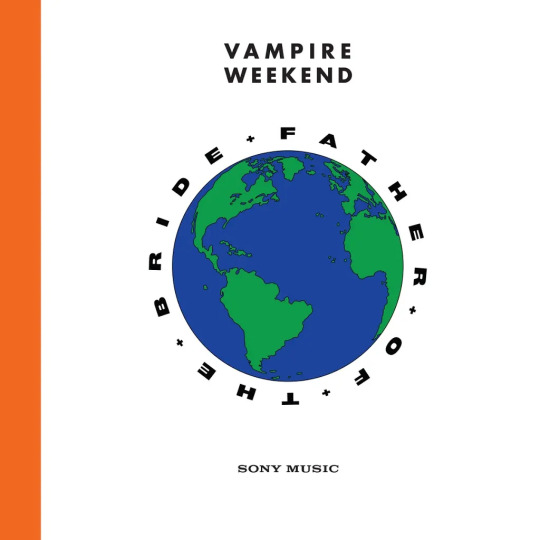
For a long time, when I was considering what could be my top album of the year, the one that stuck in my mind was this one. It had an extremely strong lead single in Harmony Hall, and multiple further tracks that I really strongly got into, the likes of Stranger and This Life, and to a lesser extent Sunflower. But I think what I’d forgotten until I started doing full album relistens, was that this is a very long album, and it wavers a lot in style and quality—and much of it didn’t land as much as I wanted it to. It’s not that it doesn’t have those glorious highs (because it does), but because albums ahead of it in this list have a level of consistency that ensure that the whole thing is a joy to listen to. Meanwhile, I’m very happy to put these 3 or 4 tracks from Vampire Weekend on a permanent loop, but it’s not enough to shoot the album into the upper echelons of the list. Standout Track: Harmony Hall.
8. Aurora - A Different Kind of Human (Step II) (dreampop)

Sam’s #1 track of 2016 was from Aurora, and as a result, we’ve collected Aurora tracks and albums as they’ve come out. But 2019 is finally the breakthrough for me when listening to her music—we had at least two lead singles before the album was released, which can often mean that the rest of the album feels like filler. But this maintained its kind of ethereal electropop throughout, combining haunting vocal hooks with swells and dips of synths in continuously compelling ways. A fine album: perhaps not one I was expecting to have this high at the start of the year. But then again, it is the year that dreampop really starts clicking for me. Standout Track: The River.
7. Bang Bang Romeo - A Heartbreaker’s Guide to the Galaxy (blues rock)

Some really solid stuff here. This is full-throated bluesy rock, sold by the powerful vocals of front-woman Anastasia Walker, and backed by a full band complete with horn section. It has moments of shuddering stadium rock, but can dial it back to sultry crooning in an instant. This was honestly a pretty late entry in the year, and often albums like this don’t have the time to percolate in my mind enough to really get them high on this list. So it’s a testament to the quality of Bang Bang Romeo that we see them up in the top ten. Standout Track: Cemetery.
6. Lana Del Rey - Norman Fucking Rockwell (folk pop)

If 2019 was the year I got into dreampop, there’s a reason why it’s also the year I really started appreciating Lana Del Rey. The other reason Normal Fucking Rockwell sees itself so high on this list is because it’s honestly fucking great. It swirls between atmospheric dreampop and a more kind of straight soft pop rock, with elements of psychedelia always in the mix. Del Rey’s vocals are always somewhat hypnotic, but here she layers a more complex lyrical sense to them. It feels as though this is a step up at just the time when I’m most receptive to it, and that makes for a high placing for an artist I wasn’t super enthusiastic about before this year. Standout Track: Venice Bitch.
5. Joseph - Good Luck, Kid (indie folk pop)

Into the top 5 we plunge, and first up is this excellent collection of music from the trio of Portland sisters, Joseph. It’s a thrilling kind of folk tunefulness, put atop a pop rock basis that drives it forward. The fusion is never complicated, and the sweet folk sounds manage to persist in tracks like Revolving Door, while they otherwise sit comfortably above a stronger rock basis in tracks like Fighter and Good Luck, Kid. It’s a smart and attractive combination. I have loads of track on this album that I want to single out in isolation, but the fact is that listening to the whole album itself is a different kind of trip, and it’s the coherence and consistency of the whole collection which ensures this is so high. Standout track: Revolving Door.
4. Sleepwalkers - Ages (indie pop rock)
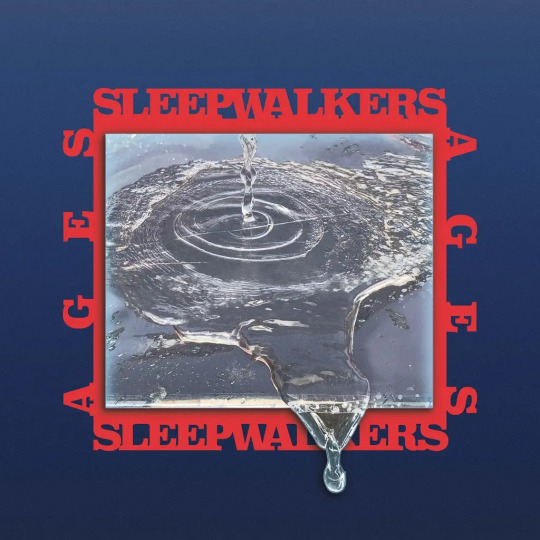
I’ll be honest with you, I was never at all expecting this to be as high as this on my list—my favourite track from the album, American Nights, is a good bit of pop rock that reminds me a bit of the 90s throwback sound of Cornershop and Supergrass, but it’s not one of the best tracks of the year for me. But the fact is that there are so many tracks here that are of that calibre. If there’s an award for consistency of an album, it has to go for this one, which is sustained in sunny poppy rock throughout, and constantly manages to find a hook to make each song memorable. Other standout tracks include I Can’t Wait, Fault Is Me, Never Enough and Attention. In the end, it’s almost a tidal wave of goodness from this album that makes its place this high inevitable. Standout Track: American Nights.
3. Sundara Karma - Ufilas' Alphabet (art pop)

Another album which overwhelms me with consistency is this adventure from Sundara Karma. There’s a really strong vibe of both later Bowie and the shuffling uncool coolness of David Byrne in this. It’s almost a kind of boundary pushing psychedelic rock at times, only performed with a dance beat and synths, or a deep groove that keeps it moving. But at the same time, it chooses very strongly to tie itself to some pop tropes which make it accessible, and almost anthemic at times. This is another album which was definitely in the conversation about end of the year lists, but which I didn’t realise deserved to be so high until I did relistening at the end of the year. This is genuinely excellent stuff, and a worth 3rd place of the year. Standout Track: Little Smart Houses.
2. Walk Off The Earth - Here We Go! (indie pop)

You may remember Walk Off The Earth for their cover of Somebody That I Used To Know which they performed with four members all playing the same guitar. But step away from the gimmick and the viral videos, and their originals (of which this album is filled full) are joyous little slices of pop. They have a quirkiness with the samples which keeps a sense of humour, and otherwise they have the kind of sunny music that makes even a day trapped in Sydney smoke haze feel like a bright day on a tropical island. Again, this is an album with a huge hit rate. Aside from my Standout Track, I’d also call out Addicted, Here We Go (Overtime), I’ll Be There, and Co-Star, honestly all of which could have been the top track on another album. Most of all, this is the kind of music that I’ve loved so much in the past. It reminds me of previous efforts from MisterWives, Moon Taxi and Jukebox The Ghost. It’s the kind of music which is designed for me. At least that’s the way it feels. Standout Track: Under a Tree.
1. ViVii - ViVii (dreampop)

What would 2019, the Year of Dreampop, be without a dreampop album at the top of the pile. During relistening, I was just swimming in this ethereal music and it just felt right. I wasn’t sure where the top of the list was going to land, but this one just felt right. In some years of the music project, it’s been fairly clear from early on what was going to be my best album of the year (2018 is the obvious example, where The Go! Team felt almost unassailable for most of the year), but this is more a decision like 2016, when I just had an emotional connection with The Space Between from Jamie Smith’s Mabon. I have that same connection here with ViVii. This exemplifies the things I’ve most come to love about dreampop—the harmonic shifts that are both unexpected and yet somehow perfect, the clear, plaintive lyrics which fit so well with the lush backing without getting breathy and whiney. But there are just so many moments in this that send a tingle up my spine, like the minor-to-major modulation in the second lines of the chorus of Savant, the off-kilter beat in the opening to Siv (You And I), which clicks into place once the baseline appears, or the bell-like guitar of Suckerpunch which morphs into a mournful solo section, even as it modulates into places you don’t quite expect. I love this album all up, and it’s the one that I really just want to most embrace and champion from 2019. Shockingly, in the week this was released, this actually only got my Runner Up Award, which was clearly a huge mistake. In my defence, the week we listened to this I had a bad bout of the flu, which can be the only rational explanation for why I didn’t see the transcendence of this album on the first pass. Luckily I rectified it in the end. Standout track: Suckerpunch.
Well, that’s it for albums. Tomorrow, I’ll post a rundown on my top tracks of the year (I have a lot of these). I’ll do those without commentary—it’s more for record keeping purposes that I do it, and so that Sam and I can compare placings of crossover songs. It’s also an opportunity for me to share a bit more of the wider music I’ve enjoyed this year, even when particular albums didn’t percolate to the top.
0 notes
Link
October 09, 2019 at 08:00AM
Carter Roberts’ motorized wheelchair didn’t arrive until the day he died.
It had been a long time coming and his parents had fought hard to get it. The chair cost more than $32,000 and the insurance companies wouldn’t cover it, so the family went to court. One insurer eventually agreed to pay for some components of the chair but not the whole thing. And then none of it mattered anyway. On Sept. 22, 2018, the Roberts’ doorbell rang and the chair was delivered. Also on Sept. 22, 2018, Carter died, just three months shy of his sixth birthday. He had been largely paralyzed for the final two years of his life. The family is only now beginning to pick their way through the horror of what happened.
“Our eight-year-old daughter believes she can speak to him,” says Carter’s mother Robin. “She was playing video games the other day and she’s looking up and going, ‘Carter are you seeing this? I need your help.’”
By any measure, the Roberts family of Richmond, Va. was spectacularly unlucky. They lost their son to a disease that science first recognized only in 2012. It’s new enough that it didn’t even have a formally accepted name until 2014. When it got one, it was one of those names that is more or less just a clinical description of what the disease is: acute flaccid myelitis (AFM), a sudden inflammation of spinal tissue resulting in flaccid paralysis of the muscles of the limbs, neck, face and often diaphragm. It’s a lot like polio but it’s not polio; it’s a little like meningitis and Guillain-Barré syndrome but it’s not them either.
Ilana Panich-Linsman for TIMEBraden’s nurse and mother set him up for treatment.
Indeed, no one knows exactly what it is. For the moment it remains rare: In the U.S., where AFM is closely tracked, the disease attacks fewer than one in a million people even in peak years, and it very rarely kills. But in the past seven years, it’s been striking more and killing more, and there is a tick-tock certainty to when it will hit next. As with polio, AFM is seasonal—though unlike polio, it arrives in late summer and early to mid fall, rather than in the spring and summer. Also unlike polio, it runs in an every-other-year cycle, peaking in even-numbered years.
While spotty outbreaks of AFM have been retrospectively diagnosed in the U.S. from 2005 to 2012, it was in 2014 that the disease established its current pattern. That year, there were 120 confirmed cases scattered around the country; in 2015, the total fell to 22 cases; it climbed again in 2016 to 149 cases; fell again in 2017 to 35 cases and jumped back up last year to 201 cases. So far in 2019, there have been 20 cases of AFM in nine states.
Now, as an even-numbered year inevitably approaches, there is a growing feeling of looming menace. When 2020 arrives—and then 2022 and 2024 and on into the future—more and more children are destined to be claimed, unless science gets a handle on the disease fast.
“This is our generation’s polio,” Carter’s mother, Robin Roberts says flatly.
That’s not just the opinion of a grieving mother; doctors admit to feeling daunted too. “I can’t think of a single disease that had this pattern that we’re seeing, with modern laboratory diagnostics not figuring it out,” says Dr. Nancy Messonnier, director of the CDC’s National Center for Immunization and Respiratory Diseases.
As with polio too, the medical community has mobilized. Back in the 1930s through 1950s, the work was led by the National Foundation for Infantile Paralysis, the non-governmental consortium of scientists that included Jonas Salk and Albert Sabin, who developed the two different versions of the polio vaccine. This time it’s the U.S. Centers for Disease Control and Prevention (CDC), which last fall formed a task force consisting principally of 17 epidemiologists, neurologists, pediatricians and other experts from teaching hospitals and health departments across 10 states, as well as from the National Institutes of Health and the Bill and Melinda Gates Foundation.
Ilana Panich-Linsman for TIMERachel Scott helps her son Braden walk down the stairs in their home.
The task force had its first meeting in December 2018 at the CDC’s headquarters in Atlanta, and the gathering had the feeling of a war council. Every seat at a massive conference table in a windowless room was full, with doctors and other staffers lining the walls and epidemiological maps and graphics on display screens.
“This is obviously complicated or we wouldn’t be in this place,” said Messonnier in her opening remarks.
Lending urgency to the task force’s work is that AFM seems not only to be getting stronger, but crueler too. As recently as 2014, the median age of AFM victims was seven years old; then it fell to five and now it’s just four and a half—kindergarteners. Like polio, it strikes at just the point when children are fairly defined by their happy, kinetic energy—and then it takes it away from them.
“It was kind of surreal to be like, ‘Wait, how rare is this? One in a million? You’ve got to be kidding me,’” says Jeremy Wilcox of Herndon, Va., whose four-year-old son Joey contracted AFM in September 2018 and lost the ability to walk, but has largely—though not entirely—recovered.
Roberts and Wilcox were in Atlanta in December to address the task force. Their ostensible purpose that day was to describe the nature of the disease to the doctors, who at this point understand it far less well than the lay families living its terrors. But the more pressing and powerful reason was to humanize the problem—to establish the mortal urgency of solving it.
“AFM has changed my life,” says Rachel Scott, mother of a third child, Braden, who is battling the disease, and who also attended the meeting. “It’s changed my children’s lives; they’re growing up in a completely different world than they would have. This is not something I ever would have dreamed of.”
Braden Scott, whose family lives in Woodlands, Texas, first came down with what seemed like a routine summer cold on July 4, 2016. But the next day, when he tried to eat so much as a single potato chip, he couldn’t keep it down—not because his stomach was upset, but because the muscles that control swallowing had begun to fail. “He got weaker over the next few days and we came to realize his swallowing was paralyzed,” says Rachel.
Ilana Panich-Linsman for TIMEMuscle-stimulating pads are placed on Braden’s back for treatment.
Eventually, the paralysis spread throughout Braden’s entire body below the neck, including his diaphragm, which meant he had to be intubated in order to breathe. He spent seven months in the hospital as the most acute phase of the disease receded and he received in-patient rehab, but even now that he’s home, his walking remains unsteady, paralysis continues in his left arm and his swallowing is still so poor he must be fed a liquid nutrient four times a day through a port in his stomach. Merely controlling his swallowing enough to clear saliva is a challenge, and though he’s back in school, a nurse who accompanies him must periodically suction his mouth so that he doesn’t choke.
“Every day when he comes home from school, we say, ‘OK, how many mouth suctions today?’” says Rachel. “Sometimes it’s only three and we’re like, ‘That’s amazing!’ The things I celebrate are absurd.”
Like so many AFM patients, Braden was at first misdiagnosed. When his parents rushed him to the hospital with fever and spreading paralysis, the doctors said his problem was mononucleosis and strep; they prescribed him antibiotics and steroids and sent him home. Joey Wilcox was first suspected of having Bell’s Palsy—his face was partly paralyzed, so what else could it be? The doctors eventually sent him home with no medicine and a vague diagnosis of a virus, one they said was likely to pass on its own. Carter Roberts’ family was told that he was merely tired and needed rest.
In many cases, the correct diagnosis doesn’t come until full paralysis has set in and doctors finally conduct an MRI of the spinal cord looking for a lesion or some other localized explanation. By that point, the extent of the disease can be startling. “Carter’s cord was so inflamed they couldn’t even distinguish between gray matter and white matter,” says Roberts.
If the damage AFM does shows up clearly on a scan, the cause of the disease doesn’t leave clear fingerprints, though experts have good reason to believe it’s a viral illness. Its seasonality is consistent with viral behavior—the way colds and flus strike in the fall and winter and polio in the spring. The biannual peaks are not unusual for a virus either. “Measles before vaccination was every two years as well,” says Dr. Thomas Clark, the CDC’s AFM Incident Manager.
Ilana Panich-Linsman for TIMESome reminders of Braden’s treatment hang on the wall in the Scott family home.
But measles—and polio, chicken pox, rubella, and other childhood viral diseases—are very different infectious beasts because they are all caused by a discrete virus, which can be detected in the blood and neutralized by vaccination. AFM is murkier. It’s thought to be associated with at least two different enteroviruses—viruses that incubate in the gut. There are hundreds of enteroviruses (including polio and influenza), and so far the ones designated EV-D68 and EV-A71 have been most widely implicated in AFM paralysis. But “widely” is not even close to “universally.”
During peak years, no more than 30% of AFM patients show some traces of EV-D68; another third show EV-A71 or other stray viruses; another third show nothing at all.
Even if the two enteroviruses turn out to be to blame, no one knows exactly how they do their damage. While the poliovirus directly attacks the ventral horn cells in the spinal column, it’s entirely unclear what EV-D68 and EV-A71 do to the central nervous system. The best analogy might be to Guillain-Barré, an inflammation of the peripheral nervous system that usually results from a misfiring of the immune system after an infection with a stomach or respiratory virus.
The mention of Guillain-Barré predictably gets the anti-vaccine crowd chattering, since a slight increase in the risk of the disease has been observed among people who receive the flu vaccine—on the order of one or two additional cases for every million vaccinations. (The CDC stresses that the risks associated with severe influenza—including death—are far worse than the far smaller risk of Guillain-Barré.) There is no evidence at all of any link between AFM and any vaccine, but the CDC all the same is investigating any possible connection, simply because good epidemiological sleuthing requires no possibility be overlooked.
“We’ve always thoroughly looked at vaccine safety in all of our programs,” says Patel. “Currently, we don’t have any evidence to suggest that there is an association.” Clark adds that the children who have developed AFM have generally been vaccinated in the same way and on the same schedule as the tens of millions of children who don’t get sick.
Ilana Panich-Linsman for TIMEOne of Braden’s nurses, Carly Westcott, RN, helps prepare him for therapy.
The more epidemiological avenues that reach a dead end, the more researchers are concluding that they are coming up against a disease more complex than they reckoned. “AFM can’t have a simple answer because if it was, all these smart people would have figured it out,” says the CDC’s Messonnier.
What alarms the CDC is the possibility that the medical community could face wave of cases before that figuring out can happen, and polio offers a precedent. The earliest documented polio outbreaks were mild: four cases in the U.K. in 1835; ten in Louisiana in 1835. In 1894, a major outbreak struck Vermont, when 132 children fell sick—and after that, the disease exploded. There was an epidemic of 27,000 cases in the U.S. in 1916, including 9,300 in New York City alone. In the years after, there were thousands—sometimes tens of thousands—of cases every summer in the U.S., with the peak coming in 1952, when 57,879 polio infections were recorded. The epidemiological fever didn’t break until 1955 when the first polio vaccine was approved.
If there are similarities in the AFM and polio infectious profile, there are big differences in the prognoses. Polio paralysis always seemed intractable—sudden and effectively permanent—while AFM patients can regain much of their function. That may say less about the infectious agent and more about the therapeutic options that are available in the 21st century and weren’t in the 19th and 20th.
Patients have access to a far better array of prostheses and far more thorough physical therapy programs than they would have 100 or even 50 years ago, with kids today sometimes working up to five and six hours a day to regain mobility. Braden Scott receives regular muscle therapy, which he refers to as “zapping,” and it’s a fair enough term for what the seven year old goes through several times a week. In each session, medical technicians paste 48 electrodes to his arms and legs, which send synchronized signals to various muscle groups mimicking the electrical commands the brain would normally send the muscles to get them moving. Regardless of the source of the signal, the impact on the muscles is the same: the motion serves as exercise, preventing the atrophy that can occur when a limb is unused. The nervous system benefits too, with the signal channel between the spine and the limb remaining open.
Ilana Panich-Linsman for TIMEBraden uses his toes to reach for a LEGO on a break inbetween physical therapy treatments.
Braden also underwent a relatively new surgical protocol known as nerve transfer, in which a healthy donor nerve from elsewhere in his body was left connected to the spinal cord but was rethreaded to his left arm, where AFM destroyed an existing nerve. Three years out from his symptoms, he continues to improve—but slowly. The tracheostomy tube that helped him breathe will soon come out, but his improvement in eating and swallowing normally—which takes the complex interplay of multiple muscles in the head and neck, as well as coordination with the throat to protect the trachea—has been much slower.
Inevitably in the U.S., any disease—especially a newly identified one with treatment protocols that are by definition unproven—will run into the wall of the health insurance system, with parents dividing their time and energy between tending their sick child and fighting simply to get coverage.
“It’s hell,” says Roberts, who battled for the wheelchair that came too late for her son. “You’re just dropped blindly in the middle of a labyrinth that is health care. You’re grasping at walls and corners trying to feel your way out, and no one is willing to hold your hand or give you a GPS.”
Toward the end of Carter’s life, his doctors recommended a drug to ease his breathing, but the insurance company refused to pay for that, too. “I pushed back as far as I possibly could until a final denial after eight months,” says Roberts. She wonders to this day whether the drug would have made a difference.
Ilana Panich-Linsman for TIMECaroline Casanova, LVN, one of Braden’s nurses, checks his blood sugar as he watches TV with his brother.
Joey Wilcox has mostly recovered, a year out from his initial symptoms. He still has some paralysis on the left side of his face and a bit of a limp in his right leg, but when he first got sick, he was so weak he referred to himself as a “floppy human.”
“I’m thinking it may have come from a video game,” says his father, Jeremy. “He said, ‘Am I always going to be a floppy human?’ My wife said no. I didn’t answer and I don’t know if I would have given the right answer because saying to your child, ‘I don’t know’ is not comforting or reassuring.” If medical history is a guide, comfort does come, reassurance does come—cures and vaccines do come. But they come only with time and only with work—as the calendar moves inexorably to the next even-numbered year.
0 notes
Photo

THE CHILDREN OF GARTH GREENHAND 12/13: HARLON THE HUNTER
Harlon the Hunter is a legendary son of Garth Greenhand and ancestor of House Tarly. He and his twin brother Herndon of the Horn built their castle atop Horn Hill and took to wife the beautiful woods witch who dwelled there, sharing her favors for a hundred years. The brothers did not age so long as they had intercourse with her whenever the moon was full.
This image will be featured on my upcoming map of THE REACH.
#asoiaf#a song of ice and fir#game of thrones#westeros#reach#garth greenhand#grr martin#manuel neuer
29 notes
·
View notes